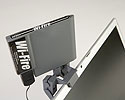If you’re having trouble maintaining (or finding) an adequate WiFi signal, hField Technologies’ Wi-Fire’s US$59 USB WiFi Adapter for Macintosh can give you a boost (pun intended). It sports an integrated high gain directional antenna and provides interoperability with any 802.11 b/g access point. And hField has released new software for the device.
The Wi-Fire multiplies the effectiveness of wireless networks and purportedly allows users to connect to a WiFi network from up to 1,000 feet, more than three times the range of AirPort cards and other 802.11 adapters. I never quite managed that distance (I’ll explain below), but certainly was able to “hit” a signal beyond what my laptop’s inherent capabilities allowed.
Another nice touch of the Wi-Fire is its compactness. It measures 3×4 inches and is merely 3/8-inch thick, so it’s very compact and portable. What’s more, it folds up so is easy to stowaway in a backpack, briefcast or carrying case.
The Wi-Fire has a directional antenna that lets you focus the leading edge toward an access point with the goal of improving transmission and reception of the signal. Basically, it tracks down a wireless signal and amplifies it enough to facilitate a working connection. You position the antenna for maximum signal independent of your laptop’s orientation.
It’s easy to connect. You clamp the Wi-Fire to your Mac laptop and plug in its USB cable. The mounting apparatus is articulated so that the antenna can tilt and swivel. You attach the Wi-Fire via friction-loaded jaws. However, the jaws aren’t spring-loaded. I understand why; if they were they might damage your laptop. However, the Wi-Fi wobbled a bit and never seemed as secure as I wished. But it never came off.
The device comes with Mac compatible (Mac OS X 10.3 or higher) software that lets you configure and connect to available networks. WEP/WPA can be input for access to secure networks. You can store frequently accessed networks as “Profiles.”
How well does it work? Though not quite as good as hField claims, pretty darn good. I used it with my MacBook at various points outside of my house in efforts to access the wireless network set up inside.
The built-in AirPort hardware/software worked up to about 275 feet, then became basically unusable. I fired up the Wi-Fire and was able to keep surfing the Net at a decent speed (about 700 kpbs). At 800 feet, I could still get a signal, but speed had dropped to about 500kpbs. At 850 feet, the Wi-Fire rated the signal as “bad” and kept dropping the connection. (Note: there were trees in the vicinity of the “testing grounds” but none clustered closely together.)
Also note that the new Wi-Fire Connection Manager 2.0 for Mac runs from an unobtrusive icon in the Mac’s Menu Bar, just like AirPort. This newest version can be downloaded here. It works on PowerPC and Intel lMacs running Mac OS X 10.4 or higher.
Like the “official” battery life of electronic devices, the Wi-Fire fell short of the hype. But not by much. hField’s device does make it easier to go wireless in more locations and stay connected. If you’re always working in a home or office environment and never push the limits of the nearest wireless network, the Wi-Fi will do you little good. However, if you do have situations where you need some help in jumping on a wireless network, the Wi-Fire is worth your time and money.
‘Wi-Fire’ makes hot spots hotter

